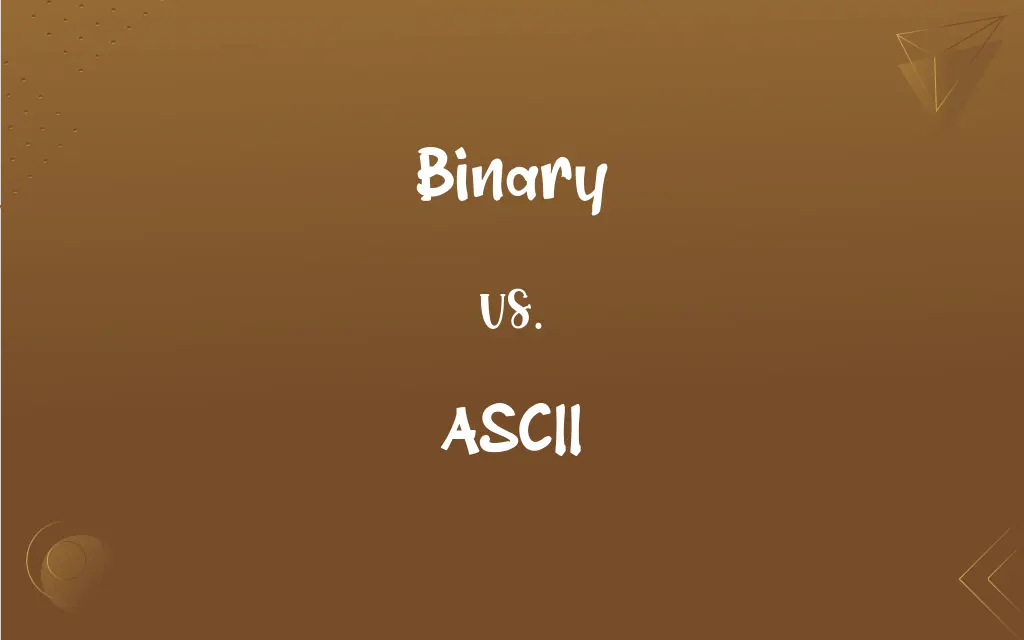Binary vs. ASCII: What's the Difference?
Edited by Aimie Carlson || By Janet White || Published on March 6, 2024
Binary is a numeral system using base 2 (0 and 1), while ASCII (American Standard Code for Information Interchange) is a character encoding standard for text.

Key Differences
Binary represents information in base 2, using only two digits: 0 and 1. Each binary digit, or bit, is the smallest unit of data in computing, representing a state of off (0) or on (1). ASCII, on the other hand, is a character encoding standard that maps binary numbers to specific characters, enabling computers to represent and manipulate text. Each ASCII character is represented by a unique 7-bit binary number, allowing for 128 different characters, including letters, digits, and control characters.
Binary is fundamental to the operation of digital computers, where data and instructions are processed and stored in binary form. ASCII uses binary to represent characters, serving as a bridge between the binary data processed by computers and the readable text used by humans. While binary underpins all data storage and processing in computing, ASCII is specifically concerned with text representation, making it crucial for text files, programming, and internet communications.
In binary, sequences of bits can represent various types of data, from simple numerical values to complex multimedia files, depending on the context and interpretation. ASCII, however, is limited to text representation, with each sequence of 7 bits corresponding to a specific character from the ASCII table. This distinction highlights the broader applicability of binary in computing versus the specialized role of ASCII in text encoding.
The use of binary extends beyond computing to various fields such as mathematics, electronics, and cryptography, where binary logic and operations are fundamental. ASCII's impact is most pronounced in the realm of computing and digital communications, where it standardizes the representation of text, facilitating compatibility and interoperability across different systems and devices. Despite its limitations and the emergence of more comprehensive encoding standards like Unicode, ASCII remains a cornerstone of text encoding in computing.
Binary and ASCII intersect in digital computing, where binary serves as the foundational language of computers, and ASCII provides a method for encoding text as binary numbers. This relationship underscores the integration of abstract binary data with human-readable text, enabling diverse computing applications from basic text editing to complex web development and data processing.
ADVERTISEMENT
Comparison Chart
Basic Definition
Base-2 numeral system using 0 and 1
Character encoding standard mapping characters to binary numbers
Usage
Represents all digital data
Represents text characters
Unit
Bit (Binary Digit)
7-bit code for each character
Scope
Universal in digital electronics and computing
Limited to text encoding
Character Set
Not applicable
128 standard characters including control characters
ADVERTISEMENT
Binary and ASCII Definitions
Binary
Binary is a base-2 numeral system using digits 0 and 1.
The number 9 in binary is represented as 1001.
ASCII
ASCII is a character encoding standard that represents text in computers.
The ASCII value for 'A' is 65.
Binary
Binary logic is essential in programming and computing operations.
Binary logic gates form the basic building blocks of digital circuits.
ASCII
ASCII uses 7-bit binary numbers to encode 128 unique characters.
ASCII includes control characters like newline, represented by the binary 0001010.
Binary
Binary is the foundational language of digital computers and electronics.
Computers use binary to process and store all types of data.
ASCII
ASCII includes printable characters such as letters, digits, and punctuation.
Each ASCII character, like '?', has a specific binary code.
Binary
Binary decisions involve a choice between two exclusive options.
The system's response was a binary yes or no.
ASCII
ASCII was developed to standardize the representation of textual data.
ASCII made it possible for different computers to exchange text.
Binary
Binary encoding is used to represent various forms of data in computing.
Images and music are stored as binary data in digital media.
ASCII
ASCII is used in programming and data processing to represent text.
Strings in programming languages are often encoded using ASCII.
Binary
Characterized by or consisting of two parts or components; twofold.
ASCII
A standard for assigning numerical values to the set of letters in the Roman alphabet and typographic characters.
Binary
Of or relating to a system of numeration having 2 as its base.
ASCII
Persons who, at certain times of the year, have no shadow at noon; - applied to the inhabitants of the torrid zone, who have, twice a year, a vertical sun.
ASCII
The American Standard Code for Information Interchange, a code consisting of a set of 128 7-bit combinations used in digital computers internally, for display purposes, and for exchanging data between computers. It is very widely used, but because of the limited number of characters encoded must be supplemented or replaced by other codes for encoding special symbols or words in languages other than English. Also used attributively; - as, an ASCII file.
ASCII
(computer science) a code for information exchange between computers made by different companies; a string of 7 binary digits represents each character; used in most microcomputers
FAQs
What is binary?
Binary is a base-2 numeral system using only 0 and 1 to represent data.
What is ASCII?
ASCII is a character encoding standard that uses 7-bit binary numbers to represent text.
How do binary and ASCII differ in their basic units?
Binary's basic unit is the bit, while ASCII's is the 7-bit code for each character.
Is ASCII sufficient for representing all world languages?
No, ASCII is limited to 128 characters and cannot represent all global languages.
Can ASCII represent special control characters?
Yes, ASCII includes control characters such as newline and tab.
Why was ASCII developed?
ASCII was developed to standardize the encoding and exchange of text between computers.
What are the limitations of ASCII?
ASCII's main limitation is its small set of characters, insufficient for non-English languages.
How do modern computers use ASCII?
Modern computers use ASCII for basic text processing and as a subset of broader encoding standards like Unicode.
What is a binary decision?
A binary decision is a choice between two mutually exclusive options.
Can binary represent non-textual data?
Yes, binary can represent all types of data, including non-textual like images and sounds.
Are binary and ASCII compatible?
Yes, ASCII characters are represented using binary numbers, making them compatible.
How has ASCII impacted computing?
ASCII has greatly facilitated text processing, data exchange, and interoperability in computing.
What replaced ASCII for broader language support?
Unicode has largely replaced ASCII for broader language support, including emojis and symbols.
How is binary used in computing?
Binary is used to represent and process all data and instructions in computers.
How does binary relate to digital electronics?
Binary is fundamental to digital electronics, defining the state of circuits as on (1) or off (0).
How does ASCII handle uppercase and lowercase letters?
ASCII assigns separate codes for uppercase and lowercase letters, differentiating them in binary.
What are the limitations of binary?
As a concept, binary itself has no limitations, but its interpretation depends on context.
What is a bit in binary?
A bit is the smallest unit of data in binary, representing a 0 or 1.
Can ASCII encode emojis?
No, ASCII cannot encode emojis; extended standards like Unicode are required.
How is binary used in programming?
Binary is used at the lowest levels of programming, especially in system and hardware-level code.
About Author
Written by
Janet WhiteJanet White has been an esteemed writer and blogger for Difference Wiki. Holding a Master's degree in Science and Medical Journalism from the prestigious Boston University, she has consistently demonstrated her expertise and passion for her field. When she's not immersed in her work, Janet relishes her time exercising, delving into a good book, and cherishing moments with friends and family.
Edited by
Aimie CarlsonAimie Carlson, holding a master's degree in English literature, is a fervent English language enthusiast. She lends her writing talents to Difference Wiki, a prominent website that specializes in comparisons, offering readers insightful analyses that both captivate and inform.






































































